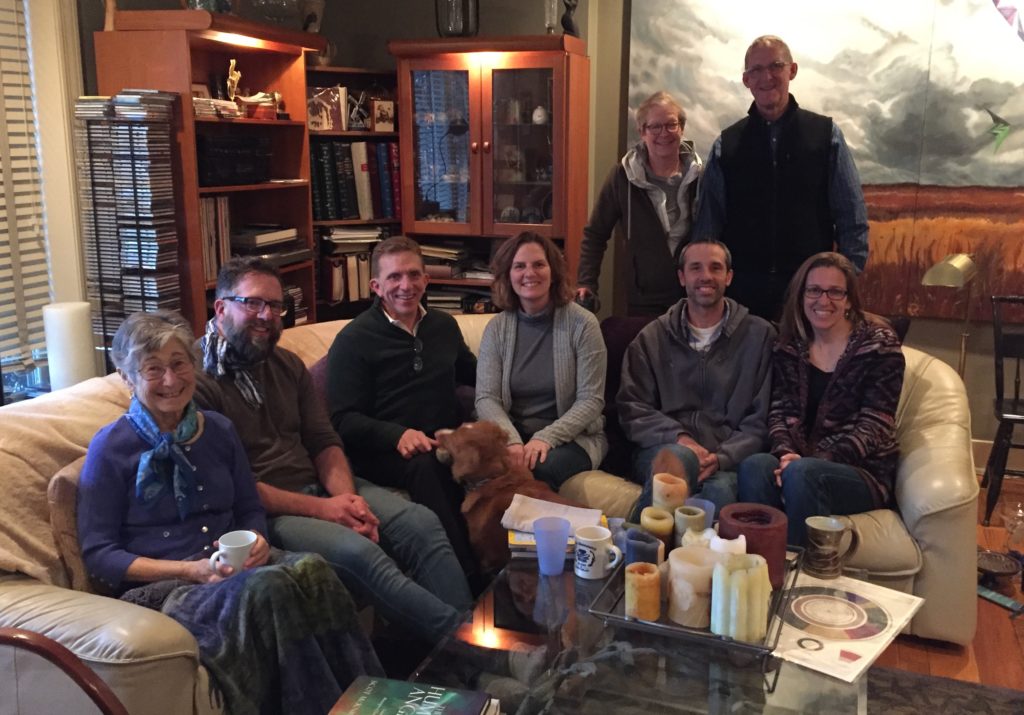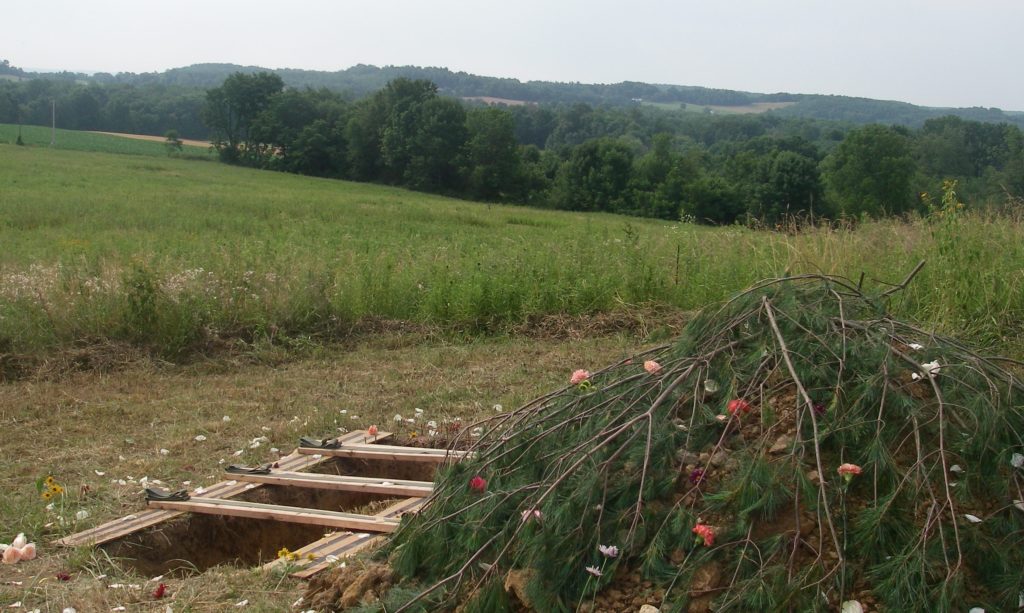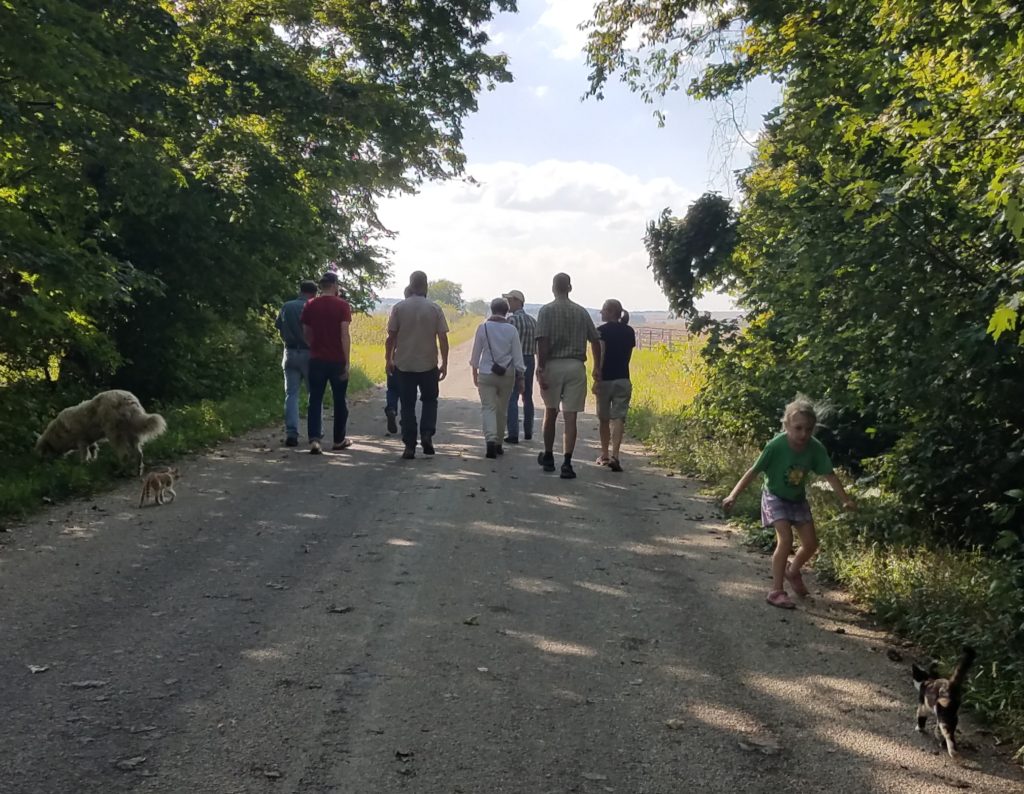Building on the first gathering that we held in the fall of 2018, a group of us came together again at a second gathering on January 12th.
My friends Lesley and Gilbert Smith generously hosted us at their home in Vernon Hills, Illinois. Despite falling snow and some tricky driving conditions, nine people came. (You can see eight in the photo along with the Smiths’ dog Linden, who is insistent on playing ball.)
I am hopeful that this kind of gathering might be something you might like to try where you live. So below I share some information on the basics of the event as well as some reflections.
We began with a prayer and then a potluck lunch. Over lunch, each person shared how their faith, life, and attentiveness to God’s earth have been woven together over time This brought us together in a significant way right away. I believe it’s not often that we get to speak about deeper things with other people.
We then cleaned up and relaxed a bit before regathering in the living room. We began there with some updates about topics and people from the first gathering, including the formation of the BEHOLD Facebook group by Jon Terry of the Au Sable Institute.
Then Lesley and Gilbert spoke in some depth about their lives, with a particular focus on what they have learned from running a tree care business for nearly four decades. In this business, they have applied their Christian values and their Christian attentiveness to helping connect their customers in thoughtful ways with the beauty and complexity of trees. This was similar to the tour of the Reimers’ family farm we received at the first gathering. The opportunity to be given deep insight into the lives and experiences of people who are interacting with people and Creation everyday is a treat.
I then gave a draft presentation to the group. I titled it “Why Tending and Defending God’s Earth Is an Essential Part of a Christian Faith-Life.” There were 10 reasons. These reasons came from my four years of writing blog posts here and much reading as well. This sparked some lively conversation. The presentation still needs much work, but I am hopeful it will be the start to something I could share more widely. I was grateful for the group’s patience, interest, and candid feedback.
We then moved into a prayer session, with everyone taking a turn. A little more than four hours after we had begun, we closed with the singing of the Doxology.
It was good. It was very good.
We live in a time when more and more of our communication is by social media, It was refreshing to talk at length together in person with people of faith who were all ready to share their challenges and hopes and deep concern for God’s earth. One of the attendees even said, “My wife and I could have hung out for hours with each person there.”
Here are some of thoughts, impressions, and lessons:
Meeting in a Home Adds a Lot: When I organized the first gathering, I actually checked out a number of meeting rooms and facilities before the Riemers generously offered to host. While there is probably a place for larger gatherings being held in larger buildings, there is something down-to-earth and just right to gathering in a home. Of course, it helps to be in a home that is full of art, books, plants of all kinds, and even a beautiful dining room table that one of your hosts handcrafted from a black walnut tree that he and his brother harvested.
Trying Not to Get Caught up in Numbers: It is so hard not to judge success by numbers. We actually had 15 people signed up to come at one point, but a number of folks had to cancel in the last two weeks. A little voice in my head wondered if this was still going to be worth doing with a smaller number. Where was the momentum?
With God’s help, I’m letting that go. I ended up very happy with how it went. In our metric-oriented society, it’s hard to let go, have faith, and focus on the quality and intangibles of an experience, isn’t it? One wise friend suggested, in fact, that too large of a group could actually hinder people from sharing their hearts openly.
Who Knew?: At the very last minute, I invited a friend and her husband, and they were able to come. The funny thing is that the friend and I have been in the same professional orbit for years. It was only very recently, however, that we learned that we and her husband were all people of the Christian faith and like-minded about God’s earth. How many other people are there out there like that in all of our circles?
Allow More Space: A good friend who attended gently pointed out that I have tended to try to squeeze in a lot of content in these first two gatherings. This was, of course, a Midwestern way of saying, “For heaven’s sake, Nathan, don’t organize the life out of these things!” Having some structure is good, of course, but we might benefit from more breathing room and organic conversation flow. I will take that to heart.
What Kind of Words?: During my presentation, conversation flared up around one of my slides that presented a forceful statement that, among other things, explicitly called what is being done to God’s earth as “violence.” There was some concern that I was speaking too boldly and provocatively. Will we, some of the group wondered, turn off Christians who are just beginning to become open to seeing that God’s earth matters? How do we express convictions and urgency without being a zealot? It occurred to me that we must somehow reconcile the fruits of the spirit with Jesus’ readiness to express anger, to speak against wrong, and to create tension. This is no easy task.
In the Shadow of Climate Change: Climate change and the chaos it is bringing were part of our conversation. One provocative thought that was shared was this – only when the scale and urgency of climate change cannot be ignored will a significant number of Christians and others look to change their ways. Christians who are paying attention and are convinced that this world that God so loves matters to God need to be ready together when that happens. But what does being ready mean? What does that look like on the land?
Truly Living by Faith: During our sharing over lunch, a number of the people there shared stories of deep faith. In some cases, it was their own experience of living on the edge between despair and hope and survival. In other cases, it was people and groups of people they had spent life with who truly lived on complete trust in God. I was also struck by the fact that a number of people there have served people in need as professionals and as volunteers and/or are doing so now. Faith and compassion can’t help but be expressed both towards people and towards Creation.
Finally, I cannot describe fully how good it was to be together that Saturday. How much our hearts and minds are inspired and expanded when we share our faith-lives deeply with others who who experience wonder in God’s Creation and who feel compelled to tend it and defend it.
I hope you already know what that kind of togetherness feels like or will in coming months.
I end with a prayer that Lesley Smith shared with me after the event. It is a prayer that she says before she and her husband Gilbert meet with a customer to talk about the customer’s trees.
Blessed are you, YHWH, creator of the universe who made the trees with wisdom and grace, without which we would all perish. Thank you for these gifts of life, healing and beauty. Father, you are the author of the light, and I ask for permission and insight to communicate with this tree for its healing and for the benefit and blessing of all Creation. Lord have mercy. Amen.







